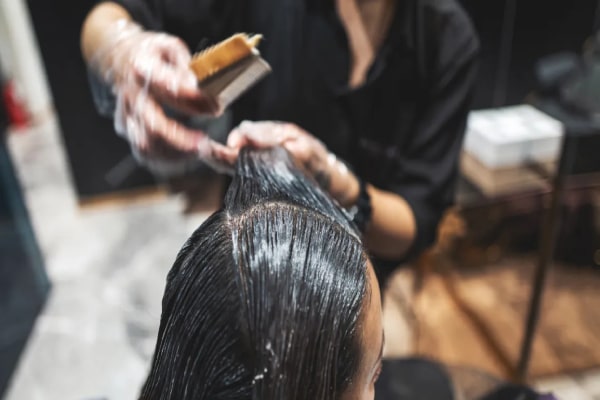Hair Schedule: What it is, How to do it and more
The hair schedule (hair routine) is a care technique that has become quite popular. The sequence of treatments can be applied to all types of curvature and helps to recover from the mildest to the most profound damage. But many people still don’t know very well how to apply it in their routines.
In this article, we will explain a little more about the technique and how the treatment steps work. Furthermore, here you will learn how to identify your hair’s needs and create a personalized schedule. Continue reading and learn how to take even better care of your locks!

What is a Hair Schedule?
The hair schedule is the organization of an agenda to periodically carry out 3 types of hair treatments: nutrition, hydration and reconstruction. The practice brings several benefits to the hair, such as softness, shine, increased hair mass and reduced frizz.
The sequence of procedures may vary depending on the type of damage and the hair’s needs at any given time. But the conditions that indicate a greater need for treatment are dryness, porosity or damage caused by chemicals such as dyes and straightening.
Strands of different curvatures such as straight, wavy, curly and frizzy can benefit from the hair schedule. Furthermore, this routine is precisely for each person to create a personalized hair treatment, and thus keep their hair healthy.
Stages of the Hair Schedule: Hydration, Reconstruction and Nutrition
Each stage of the hair schedule has a function, and it is important to understand how they work and what benefits they bring to the hair. Furthermore, each treatment requires a different type of product. Find out a little about each of the steps and their functions below!
Hydration: Replenishes water in the hair
Hydration helps to replace water lost daily due to external aggressions such as sun exposure and pollution. It combats dryness, gives softness and elasticity to the hair and leaves it shiny and bouncy. It is a procedure that can and should be done on all hair types.
As it is one of the best-known hair treatments, hydration is the most chosen way to care for your hair. It can be done with masks and moisturizing creams that contain active ingredients such as: D-panthenol, extra virgin coconut oil, aloe vera (aloe vera), glycerin, olive butter, vitamins and amino acids.
To moisturize, simply wash your hair as usual and, while the strands are still damp, coat strand by strand of hair with the cream of your choice. Wait for the pause time suggested on the product packaging and then rinse. Make sure not to leave product residue on your hair.
Read Also: How Often Should You Wash Your Hair?
Reconstruction: Replenishes mass and leaves strands fuller
Reconstruction is a deep treatment that helps restore hair fiber by replacing essential proteins, such as keratin. It is mainly recommended for strands that have undergone chemicals such as dyes and straightening, and ended up being damaged.
About 90% of hair is made up of keratin. When they go through chemical processes, the hair loses a good part of this protein and ends up lacking resistance, thin and brittle. In these cases, reconstruction treats deeply, helping to replace the lost mass.
The products recommended for reconstruction are reconstructive masks, made especially for this type of treatment. However, any product that contains keratin, collagen, arginine, creatine and cysteine is perfect for deeply treating and restoring hair health.
Nutrition: Replenishes Hair Lipids
Nutrition is the procedure responsible for returning the oils (lipids) to the hair that protect the strands from various aggressions. Lipids are fats naturally produced by the scalp. When the hair is not nourished, the oil falls, leaving the hair without its natural protective layer.
The treatment can be done with nourishing creams and masks made up of oils or butter. With fast action, these products replenish oil during the shower. Another option is to moisturize, applying vegetable oils directly to the hair before washing, leaving it to act for 30 minutes to 1 hour.
Nighttime wetting is also a good form of treatment. In it, vegetable oils are applied to the hair, left overnight and washed the next day. The oils recommended for moisturizing are: coconut oil, olive oil, castor oil, argan oil, avocado oil, among others.
How to Make a Hair Schedule?
The hair schedule does not necessarily need to follow a specific order. However, to start treatments, you must first carefully examine the hair and understand the need for it. This way you can define which step to start with. See below how to make a hair schedule!
Porosity Test
The porosity test should be the first step in your hair schedule. It will help you identify the health of your hair, as porosity is what indicates the hair’s ability to absorb nutrients or not. Follow the porosity test step by step below:
- Fill a clear glass with filtered water.
- Run your hand through your hair, find some loose strands and place them in the cup.
- Wait about 10 minutes.
- Check the position of the wires in relation to the water (whether they sank, floated or remained in the middle of the glass).
Result: strands that sink are the most damaged and porous and require reconstruction. Strands that remain on the surface may be dry and need hydration. The hairs that are in the middle of the glass indicate medium porosity, so it is worth nourishing even though hydration is up to date.
Organizing the Hair Schedule Agenda
The hair schedule agenda should be organized as follows: choose 3 days of the week to carry out one of the treatments on each of them. An interval of 48 hours must be maintained between stages. So, washing your hair on Monday, the next washes will be on Wednesday and Friday.
Generally, the schedule is completed in 4 weeks, and there is no correct order for treatments. But, most of the time, it starts with hydration, after all, it replaces the water in the right amount, making the hair better absorb the nutrients it will receive in nutrition and reconstruction.
Hydration Schedule
The hydration schedule must be followed to recover dry, rough, brittle hair, with frizz and split ends. Recapitulating the porosity test, the dried strands are those that remained floating on the surface of the water. In these cases, the schedule must follow the following order:
- Week 1: hydration, nutrition and hydration
- Week 2: hydration, hydration and nutrition
- Week 3: hydration, nutrition and hydration
- Week 4: Hydration, Nutrition and Rebuilding
Nutrition Schedule
The strands that remained in the middle of the glass in the porosity test are those that require a nutrition schedule. The treatment is ideal for hair that tends to tangle easily and has a frizzy, dull appearance. The sequence of the nutrition schedule is as follows:
- Week 1: nutrition, hydration and nutrition
- Week 2: nutrition, nutrition and hydration
- Week 3: nutrition, hydration and nutrition
- Week 4: nutrition, hydration and rebuilding
Reconstruction Schedule
Schedule recommended for very damaged and fragile strands, which have undergone chemical processes and have their cuticles completely open. In the porosity test, these are the strands that completely sank, as, due to their high porosity, they absorb water easily. The order of treatments follows:
- Week 1: hydration, nutrition and hydration
- Week 2: hydration, nutrition and rebuilding
- Week 3: hydration, nutrition and hydration
- Week 4: Hydration, Nutrition and Rebuilding
Read Also: Skincare Routine – Everything You Need To Know
Conclusion
Here you’ve learnt a little about the hair schedule and how it can help recover damaged hair. Now you know how to identify when your locks need hydration, nutrition, or reconstruction. But don’t forget to follow the order of treatments according to your needs!






